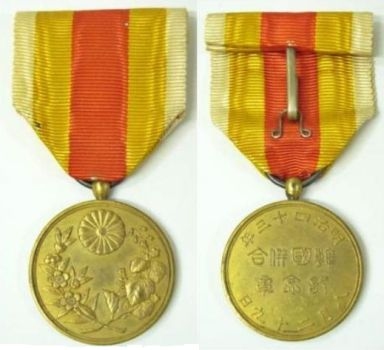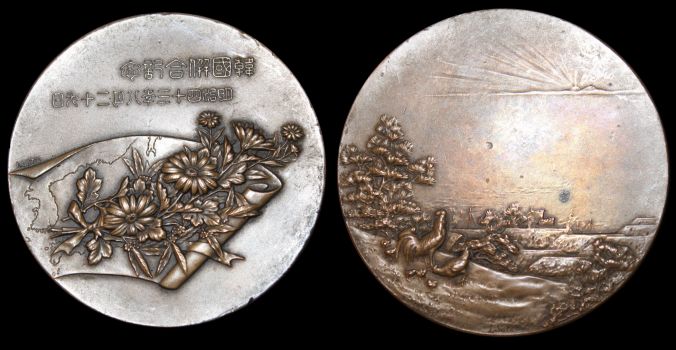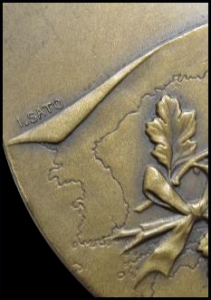The Japan–Korea Treaty of (Nov. 17) 1905, known in Korea as the Eulsa Treaty (을사조약, 乙巳條約) deprived Korea of its diplomatic sovereignty and made Korea a protectorate of Imperial Japan.1 Roughly five years later, the Annexation Treaty was proclaimed and became effective on August 29, 1910, officially starting the Japanese colonial period in Korea. The treaty had eight articles, the first being: “His Majesty the Emperor of Korea makes the complete and permanent cession to His Majesty the Emperor of Japan of all rights of sovereignty over the whole of Korea”. Koreans, when referring to the Annexation Treaty of 1910, often use the term 경술국치 庚戌國恥 “National Humiliation of the Year of Gyeongsul”2 or 국치일 國恥日 “National Humiliation Day”. Another term used by Koreans is 강제조약, “The Coerced Treaty”. With the Annexation of Korea, the Great Korean Empire 大韓帝國, established in October 1897, ceased to exist, making the Korean peninsula a Japanese colony until the end of WW2.
The Medal

In 1910, Japan officially absorbed Korea into the Japanese Empire, but the Korean Annexation Commemorative Medal 韓國併合記念章 wasn’t issued until 1912.
A proposal to issue a medal commemorating the event was approved by the Prime Minister and on Feb. 9, 1912, it was passed to the cabinet for study. On Mar. 5th, it got an approval from the Legislation Bureau and on March 28, 1912, the medal was created when the Emperor Meiji issued Edict 56, just 4 months before his death July 30, 1912.
Those who were to receive this medal were described in article 3 of the Edict as 1) those that were directly involved in the project to annex Korea and those who engaged in activities initiated in support of the annexation, 2) Officials and equivalent personnel stationed in Korea at the time of the annexation, and Korean officials and equivalent personnel within the Korean government at the time of annexation, and 3) Those who had previously contributed to Japan-Korea relations. This edict also mentioned for the first time that the medal could be presented to a bereaved family in cases where the intended recipient had passed away before the awarding. Posthumous award criteria is not found in earlier commemorative medal edicts.
The medal’s obverse has two flowering tree branches crossed under the chrysanthemum crest, with the right side branch being from a paulownia tree, representing Japan and the left side branch being from a plum tree, representing Korea. 3
The medal reverse has the year on top as 明治四十三年 “43rd Year of Meiji” (1910). There are two lines across the center which read as 韓國併合 “Korea Annexation” and 記念章 “Commemorative Medal”. The remaining part of the date is at the bottom 八月二十九日 “August 29th”. The planchet is in brass/bronze and 30 mm in size.4 There are no versions manufactured in gold or silver. The ribbon is 36 mm watered silk, with 4 mm white edge stripes, 9 mm yellow stripes and a 12 mm vermilion center stripe. 5 Article 2 of the Imperial Edict said that the medal was to be worn on the left side of the chest. There are some discrepancies regarding the total number of medals issued, but the award documents have serial numbers up into the 37,400 range. The award documents were not issued until May 3, 1913, but all of them carry the award date of Aug. 1, 1912. There is no mention of a medal specifically designed for women. The master mold for this medal is attributed to 佐藤磐 Ban Sato, who also designed the mold for the reverse side of the 1915 Taisho Enthronement Medal. The cases were light paulownia sandalwood, which was a departure from the lacquered cases used for the previous 3 war commemorative medals.


The Inscription on the obverse is 韓國併合記念 “Korean Annexation Commemorative” (한국 합병 기념관), and the date 明治四十三年八月二十九日 “43rd Year of Meiji, 8th month 29th day (Aug. 29, 1910)”.
The reverse is said to symbolize that a new day is coming to Korea.
Chinilpa 친일파 親日派
To give an idea of how the Koreans view this medal, the five Korean cabinet ministers who agreed to make Korea a protectorate in 1905, the seven cabinet ministers who signed away Korean sovereignty to Japan in 1907 and the nine Koreans involved in the Annexation Treaty of 1910, are all referred to as Chinilpa, which in today’s connotation means “National Traitor”. Another term that is often used is 매국노 Maekukno, “Betrayer”. In 2005, one hundred years after the signing of the Protectorate Treaty, the South Korean government created the “Special Law to Redeem Pro-Japanese Collaborators’ Property”. Any assets confiscated from the descendants of Chinilpa are used to compensate pro-independence activists and their offspring. In 2010, a commission concluded its five-volume report, by which the real property of 168 South Korean citizens has been confiscated by the government, these citizens being direct descendants of pro-Japanese collaborators.
Not everyone, who was eligible to receive this medal, actually took possession. There are documented cases where eligible recipients refused to accept. Some eligible recipients, rather than support the Japanese, either quit, retired, or went into self-imposed exile in another country. On August 29, the date that the Annexation was announced, public gatherings were prohibited, and the newspapers were closed down. There were several people who committed suicide to express their resentment, but their bereaved families were threatened by the police, not to reveal what had transpired. Even earlier, when Korea was placed as a protectorate of Japan, there were Koreans who committed suicide. Min Young-hwan 민영환 閔泳煥 is probably the highest member of the Korean Royal Family to commit suicide, rather than live under the Japanese.
Footnotes:
- Eulsa refers to the sexagenary calendar system of China. Here the term Eulsa specifically references 1905, but Eulsa also corresponds to other years such as 1965, 2025, 2085, etc. which are 60 years apart. It was used throughout the East Asian cultural sphere.
- Gyeongsul is another sexangenary calendar reference. Here it refers to 1910. It can refer to 1850, 1910, 1970, 2030, etc.
- The Korean Royal Family was named Yi (Lee) and is written in Chinese as 李 which means “Plum” or “Plum Tree”. It is one of the most common surnames in Asia.
- There are websites which state that it was also issued in silver, but I cannot confirm.
- According to the James Peterson monograph “Orders & Medals of Japan and Associated States”, the red and white stripes represent the national colors of Japan while the yellow and white stripes represent the national colors of Korea.
